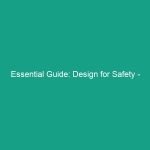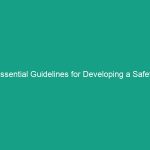Introduction
Health, Safety, and Environment (HSE) is a critical aspect of any workplace, especially in industries where employees are exposed to hazardous conditions. Among these challenges, working in a confined space poses unique risks that can lead to severe injuries or fatalities if not managed properly. A confined space is generally defined as an area that is large enough for an employee to enter and perform work, has limited means of entry or exit, and is not designed for continuous occupancy. Understanding the associated dangers and implementing proper Safety protocols is essential for preventing accidents and ensuring the Safety of workers.
This article aims to provide essential safety tips for working in a confined space, covering regulatory frameworks, best practices, real-world case studies, the challenges faced, and future trends in safety management. By the end of this guide, you will have a comprehensive understanding of how to navigate the risks involved in confined spaces effectively.
Regulatory Frameworks for Confined Space Safety
In many countries, regulatory frameworks govern the safety protocols that must be followed when working in confined spaces. Understanding these Regulations is crucial for compliance and ensuring worker safety. In the United States, the Occupational Safety and Health Administration (OSHA) has set forth specific Standards for confined space entry, primarily found in 29 CFR 1910.146.
Key Regulations
osha’s confined space regulation requires employers to identify potential Hazards, provide necessary Training, and implement Safety Measures such as:
- Hazard Assessment: Before entry, a thorough assessment must be conducted to identify potential Hazards such as toxic gases, lack of oxygen, or equipment Operation.
- Permit System: A written permit process is required to ensure that all safety protocols are followed before entry into a confined space.
- Training: All employees working in or near confined spaces must receive proper training on hazards, safe practices, and emergency Procedures.
International Standards
Globally, standards such as ISO 45001 and the International Labour Organization (ILO) also emphasize the importance of managing safety risks in confined spaces. These guidelines encourage a proactive safety culture and continuous improvement in practices. Organizations that adhere to these international standards demonstrate a commitment to health and safety, ultimately leading to fewer accidents and enhanced workplace morale.
Best Practices for Confined Space Safety
Establishing and adhering to Best Practices is essential for mitigating risks associated with confined spaces. Here are some key strategies that organizations should implement:
Pre-Entry Procedures
Before entering a confined space, it is crucial to perform several key procedures to ensure safety:
- Atmospheric Testing: Conduct tests to check for oxygen levels, toxic gases, and flammable substances. Continuous monitoring is ideal to detect any changes in atmospheric conditions.
- Isolation: Ensure that all equipment and machinery in the vicinity are properly shut down and locked out to prevent accidental activation.
- Emergency Plan: Have a clear emergency response plan in place, including the availability of rescue equipment and trained personnel.
Effective Communication
Communication is vital when working in confined spaces. All team members should be aware of the entry and exit procedures, as well as the roles and responsibilities assigned to each person. Regular safety briefings can help reinforce these protocols and ensure everyone is on the same page.
Use of Personal Protective Equipment (PPE)
Proper use of Personal Protective Equipment (PPE) is essential when working in confined spaces. Depending on the hazards identified, workers may need:
- Respirators for airborne contaminants
- Hard hats to protect against falling objects
- Protective gloves and clothing to guard against chemical exposure
Ensuring that all PPE is suitable for the specific hazards present in the confined space is crucial for maintaining safety.
Continuous Training and Drills
Regular training and safety drills play a significant role in enhancing the preparedness of employees who work in confined spaces. Training should cover the latest safety protocols, hazard recognition, and emergency response procedures. Conducting drills helps familiarize employees with the equipment and processes, ensuring a swift and effective response in emergencies.
Real-World Case Studies
Analyzing real-world case studies can provide valuable insights into effective confined space safety practices and the consequences of neglecting them. Here are two notable examples:
Case Study 1: The Tragic Loss in a Wastewater Treatment Facility
In a tragic incident at a wastewater treatment facility, two workers lost their lives due to a lack of proper atmospheric testing before entering a confined space. The workers entered a tank that had been previously cleaned but had not been tested for hazardous gases. The facility did not have a permit system in place, leading to unsafe entry. This incident underscores the critical importance of adhering to safety regulations and conducting thorough assessments before any entry.
Case Study 2: Successful Rescue Operation in a Construction Site
In another case, a construction worker fell into a confined space within a building site. Thanks to the effective communication and quick response of the emergency team, the worker was rescued within minutes. The site had established a clear emergency plan and conducted regular training drills, which contributed to the successful rescue. This case illustrates how preparedness and training can save lives in dangerous situations.
Challenges in Confined Space Safety
Despite regulatory frameworks and Best Practices, there are several challenges that organizations face regarding confined space safety:
Employee Compliance
Ensuring that all employees comply with safety regulations can be difficult, especially in high-pressure environments where time is of the essence. Some workers may feel pressured to complete tasks quickly and may overlook safety protocols. Organizations must foster a safety-first culture that emphasizes the importance of compliance and encourages workers to speak up about unsafe practices.
Dynamic Work Environments
Many confined spaces are dynamic environments, with conditions that can change rapidly due to work being performed or the introduction of new hazards. Continuous monitoring and adaptability are necessary to address these changes effectively. Organizations should invest in real-time monitoring technology that can provide immediate data on atmospheric conditions to ensure worker safety.
Limited Resources
Smaller organizations may struggle with limited resources for training and compliance. This can lead to inadequate safety practices and a higher risk of accidents. To overcome this challenge, organizations can collaborate with safety consultants and local regulatory agencies to access training programs and resources that enhance their safety protocols.
Future Trends in Confined Space Safety
The future of confined space safety is likely to be shaped by technological advancements and evolving safety practices. Here are some trends to watch:
Integration of Technology
Technology is playing an increasingly important role in enhancing Safety Measures for confined spaces. Innovations such as drones and remote monitoring systems can be utilized for pre-entry inspections and continuous atmospheric monitoring, minimizing the need for workers to enter hazardous environments.
Enhanced Training Programs
The use of virtual reality (VR) and augmented reality (AR) in training programs is on the rise. These technologies can create realistic simulations of confined space scenarios, allowing workers to practice their responses to potential hazards in a safe environment. This method of training can significantly improve retention and readiness in real-life situations.
Focus on Mental Health
As awareness of mental health issues grows, organizations are beginning to recognize the importance of psychological safety in the workplace. Employees who feel psychologically safe are more likely to report hazards and unsafe practices. Companies should foster an environment where workers feel comfortable discussing safety concerns without fear of reprisal.
Conclusion
Working in a confined space presents significant safety challenges that require careful consideration and proactive measures. By understanding regulatory frameworks, implementing best practices, learning from case studies, addressing challenges, and embracing future trends, organizations can create a safer working environment for their employees. The importance of maintaining a culture of safety cannot be overstated, as it ultimately protects lives and enhances productivity.
As a call to action, we encourage all organizations to review their confined space safety protocols and make necessary improvements. Regular training, compliance with regulations, and a focus on communication can significantly reduce risks and enhance the safety of workers in confined spaces. Remember, safety is not just a set of rules; it’s a mindset that must be cultivated at every level of the organization.


